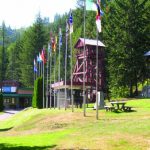LETTER: Community development as reality TV
Dear editor,
Congratulations to both the Rossland Learning Centre Project and to the Nelson Skate Park project for making it to the finalist stage of the Aviva Community Fund Competition. Good luck in the finals.
Over the last few weeks I have received several requests a day to vote in this competition. The initial requests came from Rossland. I did start voting for the Rossland project, and then on day 2 or 3 of the semi finals, I received an email from a friend who asked for support for the skate park proposal in Nelson. While I was dealing with “do I support community education or a skate park” dilemma, another email arrived asking for support for a mobile health clinic for migrant farm workers in the lower mainland, yet another great idea. I could only vote once a day, and if I voted for the clinic, or the skate park, I couldn’t support Rossland. That realization led me to take a more careful look at all the semi-finalist projects. What a fascinating collection of community initiatives, 95 in total, all designed to help the communities they represent in some way. They were all “competing” for a total of $1,000,000. Last year that prize was split between 8 small, medium and large scale projects. Only one of those winners was in a rural community.
I did vote a couple of more times after that, but found myself feeling very uncomfortable about it. The last time I voted I supported a project in a small community in Nova Scotia. Based on their low vote count, they clearly needed some moral support. Then I stopped voting altogether. Why?
This competition is really a clever advertising campaign funded by the 6th largest insurance company in the world. They are listed on both the New York and London stock exchanges. Last year Aviva had $95 billion in sales with $4.5 billion net. I tried unsuccessfully to find information on Aviva executive compensation, but the industry average is about $1.2 million per year. In return for an approximate 1 in 200 chance of winning money for a community project, Aviva engages community activists in spreading the Aviva brand in the communities those activists represent, or as the web site says to “reach out to your friends, family, the media, and anyone and everyone” and ask you to go to the Aviva web site and vote daily to support their community project. I didn’t know about Aviva Insurance prior to this competition, but Aviva is now permanently tattooed on my brain, in the “good guys” section, because after all, this is about community. With those two critical pieces in place, the final advertizing payoff in the form of a “find a broker” button is right there on the front page of the Community Fund Competition website. What a brilliant corporate marketing strategy. Both the “cost effective advertizing” and the “corporate responsibility” boxes get checked at the same time! This initiative puts both communities and project ideas in competition with each other. Because there is no initial screening based on proposal quality, project type, or scale of community, stray dogs and cats get to compete against the homeless (both people and cats), playgrounds for kids, the health of migrant farm workers, youth suicide prevention, community education, ecological restoration and 500 baby songbirds; Rossland, the Township of Asphodel-Norwood and the Village of Utopia get to duke it out with Etobicoke, Surrey and North Vancouver. And, according to the Aviva web site, all of this competition will “make Canada an even better place to live!” There were 1,725 contestants this year, with 95 making the semi final voting stage and 30 making the final “judged” competition. For each winner in this competition, assuming there will be 8 again this year, there will be 215 losers. This is a popularity contest, at least until it gets to the final “top 30.” It is heavily biased toward urban areas and those communities that already have the resources and capacity to be competitors. So, homeless cats in Toronto will make it to the top 30 and a playground for kids in Hodges Cove, NL won’t. No contest really. Most of the smaller rural communities that could have really used the financial help, like the Redfish School for Change in New Denver, had already fallen by the wayside before the semi finals, and those left in the competition had a very slim chance of making it to the finals. But that makes sense for Aviva. There are a lot more potential clients in urban areas. This competition is open to all sorts of wild and wonderful ideas, and some of them in the original 1,725 did border on wacky! I must admit that I’m not overly concerned about not seeing some of them in the top 30. But most project ideas in that “loser” list are good ones, and I do wonder how many of those communities still have project momentum. I’ve talked with friends in Rossland and Nelson who believe that even if their projects don’t win in the finals, they have gained a lot of traction through this process and will continue to look for other avenues of support. I hope that has happened in other communities as well because if this competition uses up the available community goodwill and volunteer energy in a losing cause, then I’m not sure the total pain of the many is really worth the gain of the few. I don’t see how that pain makes Canada an even better place to live. That’s the potential dark side of this Aviva Insurance Community Fund competition. As far as I can see, this is Canadian Idol applied to community development. I stopped voting because I don’t want to participate in a program that turns great community ideas and initiatives into “losers” because they can’t win a popularity contest based on vote count. I believe communities are too important to be treated like contestants in a reality TV show, especially in the interests of Aviva corporate branding. They deserve better than that, especially the smaller rural communities that didn’t have much of a chance to begin with. They have already lost so much in the larger day to day political and economic competition. If Aviva is truly interested in making Canada an even better place to live, they could drop the advertizing campaign and like many other socially conscious businesses, set up an arms length trust to administer these funds and to screen project proposals based on merits such as project quality, community need, or impact in the community. Many projects would still not get funding, but at least that decision would be based on their relative community benefits rather than on popularity contest. That would give smaller rural communities a better chance of being successful. That approach, however, wouldn’t be nearly as effective in helping Aviva’s bottom line. George PenfoldCastlegar, BC.




















